The fabled Xingu River, with its dark blue waters and unusual rock formations, is a 1230 mile long river in the north of Brazil and one of the principal tributaries of the mighty Amazon river. Here in the lower Xingu, on a 80 kilometer bend through the ancestral territory of several indigenous tribes, the Brazilian government is moving ahead with construction of the third-largest dam in the world, one of the Amazon’s most controversial “development” projects: the Belo Monte Dam.
In the distance, just above the pale scraped shore in the center of the photograph, there is a small white marker: this is the proposed site of the eventual dam. To the west (right) the river water will be stanched by the dam and diverted into a gigantic reservoir, flooding hundreds of square kilometers of rainforest, farms, and portions of the urban center of the Amazonian town of Altamira. To the east (left), the river’s flow will be reduced to a malaria-infested trickle, depriving downriver communities of their lifeline.
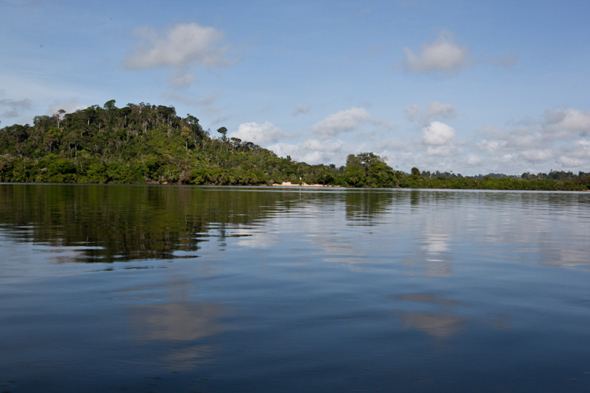
The weatherbeaten Amazonian town of Altamira, in the Brazilian state of Para, was once a farming, fishing and small-scale mining community. It has recently transformed into a dam-driven boom town, with elevated crime rates, strained social services, and increased drug and alcohol use. A third of this city (including the port shown below) will be flooded by the Belo Monte dam.
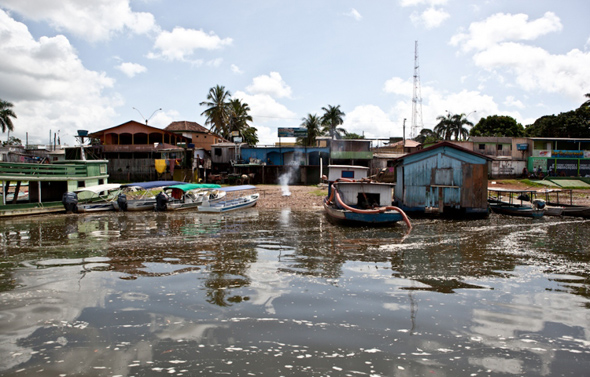
Inhabitants of the region — indigenous peoples, farmers, fishers, and the townspeople of Altamira — have formed a resistance movement against the dam, known as Movimiento Xingu. This map, drawn by community members, hangs as a centerpiece in their offices in Altamira.
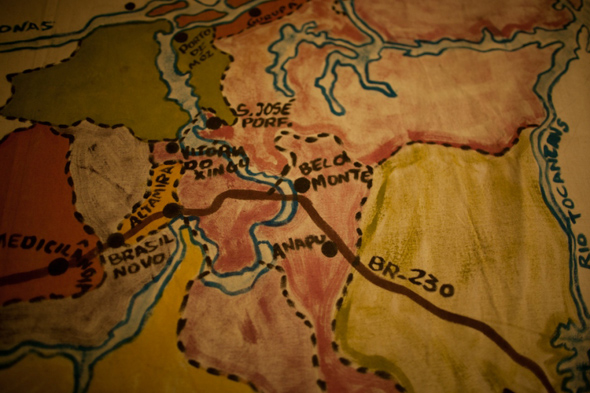
The lower Xingu is the ancestral territory of many indigenous tribes, including the Arara, Juruna, Kayapo and Munducuru people. These tribes have been living off the bounty of the rivers and the forest for hundreds, if not thousands, of years. The Belo Monte dam threatens their very survival. Here, members of the Munducuru tribe display strength at a meeting convened by the Movimiento Xingu on June 13th in the dam-affected community of San Antonio, approximately 50 kilometers west of Altamira. The Movimiento Xingu meeting in San Antonio was convened only days before the Brazil-hosted UN Earth Summit in Rio de Janeiro (Rio+20) next week in order to develop local strategies of resistance to the dam, and to bring international attention to the egregious violation of human rights and the imminent threats facing the ecosystem of the Xingu.
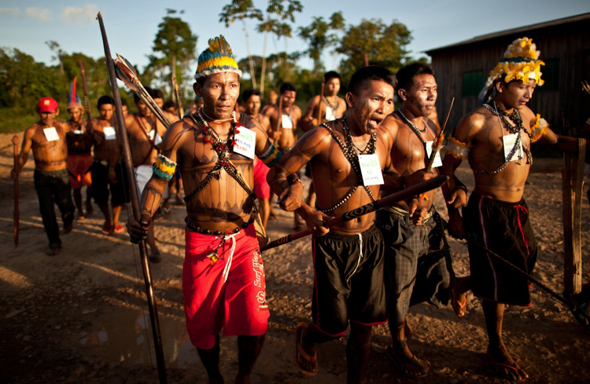
The Belo Monte Dam, which is expected to be the third largest in the world with investments totaling upwards of $18 billion, is being financed and built by what is known as “The Consortium” — a group of Brazilian state-owned energy companies and private mining interests. Despite decades of strong local and international resistance to the proposed dam, the Consortium won “legal rights” to begin construction of the Belo Monte dam complex in late 2011. Since then, construction has moved ahead at a startling pace, with armies of dam construction crews carving out massive diversion canals through the forest, as well as building a series of coffer dams downriver from the proposed dam site.
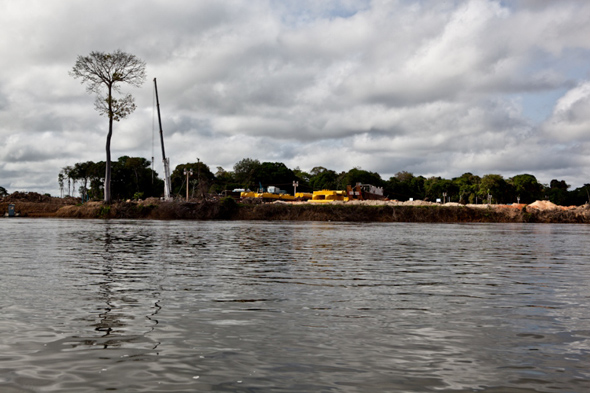
The scale of the undertaking for the Belo Monte Dam Complex, in terms of work force and engineering challenges, is absolutely staggering. Already, within the first year of construction, the Consortium has employed upwards of 5000 workers, working in a consistent two-shift rotation six days a week. Even at the Movimiento Xingu gathering yesterday, the dirt roads off the trans-Amazon highway were clogged with trucks and dam workers.
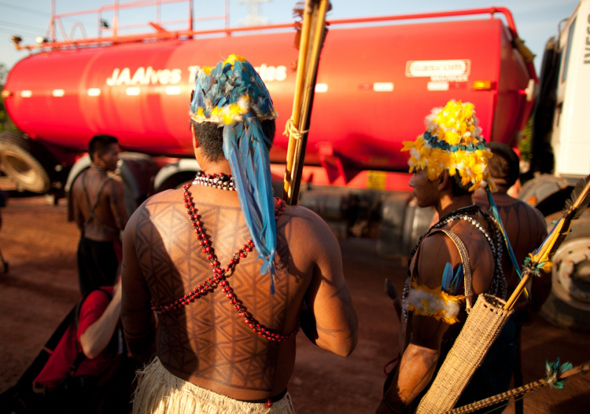
Many of the farmer and fisher families in the region have been displaced from their homes by the Consortium. The “community relations” tactics employed by the Consortium can vary, but as a rule the Consortium offers a small, usually insulting payment to local landowners for their property. If the payment offering is rejected, the Consortium will threaten eminent domain. Also, landowners have very little legal recourse to protect their land from expropriation, given the Brazilian Government has declared the areas surrounding construction of the Belo Monte dam as “areas of impact” and thus part of the “public interest.”
In this photograph, a young boy stands at night outside the community of San Antonio, just across from a major Belo Monte work base. Many residents of San Antonio have been evicted from their properties. There have been several instances of the Consortium burning and bulldozing homes, churches and cemeteries.

The Brazilian Government has plans to build 70 large dams across the Amazon rainforest over the coming decades, and they are touting hydroelectric power as a solution to Brazil’s periodic blackouts and as a “clean development” approach to global climate change. In reality, the Belo Monte dam will cause foreseeable environmental devastation, including species extinction, malarial infestation, and high CO2 emissions from the methane released by the rotting and flooded forest. If built, it will also lead to the destruction of the ancestral territory and culture of the Kayapo, the Juruna, the Arara, and the Munducuru indigenous tribes, as well as an end to the way of life of thousands of farmers and fishers in the region, who depend on the forest and the river for their livelihoods.
The fight against the Belo Monte Dam has reached a critical juncture, where the survival of the forest, the river and the people of the Amazon hangs in the balance.
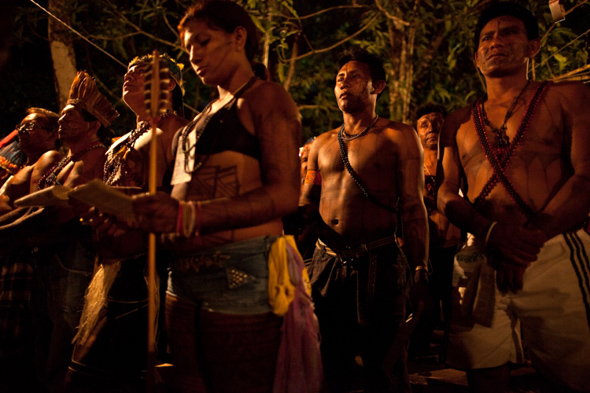
For more information and to get involved in the fight against Belo Monte, visit www.amazonwatch.org.